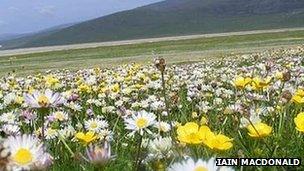VisitScotland and North Highland Initiative inspired by Slovenia flower fest
- Published

Scotland's flora resources include the Hebrides' coastal flower meadows
Scotland's wild flowers could help the country's tourism industry blossom.
VisitScotland and the North Highland Initiative, a group set up by Prince Charles, have taken a keen interest in a Slovenian wild flower festival.
According to Ian Mitchell, of Scottish Natural Heritage (SNH), they are among bodies "eager to develop" their own events using Slovenia's as a template.
Bohinj International Wild Flower Festival has grown from a local event to a key environmental celebration.
Mr Mitchell, a regular visitor to Slovenia, helped to establish the festival.
In Bohinj, he is known by the nickname Oce za Festivala - Father of the Festival.
Writing in SNH's The Nature of Scotland magazine, Mr Mitchell said there had been Scottish interest in trying to replicate Slovenia's successful event.
He said from being held during quieter times for tourism, it had been expanded into the main part of the tourist season.
Mr Mitchell wrote: "From a small local affair in 2007, it is now regarded as Slovenia's premier environmental event, supported directly by both the Slovene government and the Triglav National Park which covers much of the Bohinj area.
"Its patron is no less than the president of the Republic of Slovenia, Dr Danilo Türk, and it has forged links with Plantlife International, VisitScotland and the North Highland Initiative in Scotland together with a number of countries in south east Europe all eager to develop their own festivals based on the Bohinj model."
Celebrating a variety of wild flowers, the festival features explanations of folklore surrounding the plants and sales of local produce.
There is also traditional dancing and demonstrations of making hay by hand and creating wild flower bouquets.
In Scotland, rare wild flowers include Scottish primrose.
On the Hebrides, traditional farming methods have also been encouraged to protect fertile coastal flower meadows.
The land, known as machair, provides habitat for rare wildlife, including the great yellow bumblebee.
In 2009, a £2m funding package was put together with contributions from Europe and public bodies to help crofters to farm using traditional practices.
- Published9 May 2012
- Published1 November 2010